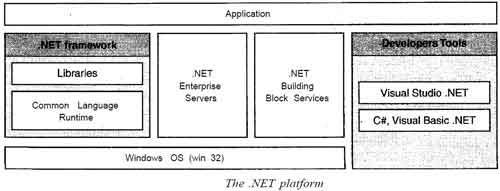We’ll be covering the following topics in this tutorial:
INTRODUCTION
The .NET is the technology from Microsoft, on which all other Microsoft technologies will be depending on in future. It is a major technology change, introduced by Microsoft, to catch the market from the SUN’s Java. Few years back, Microsoft had only VC++ and VB to compete with Java, but Java was catching the market very fast. With the world depending more and more on the Internet/ Web and java related tools becoming the best choice for the web applications, Microsoft seemed to be loosing the battle. Thousands of programmers moved to java from VC++ and VB. To recover the .market, .Microsoft announced .NET.
But Microsoft has a wonderful history of starting late but catching up quickly. This is true in case of .NET too. Microsoft put their best men at work for a secret project called Next Generation Windows Services (NGWS)., under the direct supervision of Mr. Bill Gates.
The outcome of the project is what we now know as .NET. Even though .NET has borrowed most of it’s ideas from Sun’s J2EE, it has really outperformed their competitors.
Microsoft’s VC++ was a powerful tool. But it was too complex. It has too many data types, and developers had to learn many libraries including Windows SDK, MFC, ATL, COM etc. There were many data type compatibility issues while exchanging data between different layers. Visual Basic was too easy, and many serious programmers hated it just for that reason. Even though Visual basic was very easy to use, it was not very flexible to develop serious applications. SUN’s Java became a very good choice for these reasons. It had the flexibility and power of C++ and at the same time easy enough to catch the attention of VB programmers.
Microsoft recognized these factors and they introduced the .NET considering all these factors. All unwanted complexities are eliminated and a pure object oriented programming model was introduced. This makes programmer’s life very easy.
.NET is said to be Microsoft development model in which software becomes platform and device independent and data becomes available over the internet. Due to this vision Microsoft .NET is also called Microsoft strategy for connecting systems, information and devices through web services so people can collaborate and communicates effectively.
The Microsoft .NET vision
The idea that all devices will some day be connected by a global broadband network
(Internet) and that software will become service provided over this network. “.NET” has been applied to everything from the next version of the Windows operating system to development tools.
Major Problems before .NET:
The following are the major problems in previous Microsoft Technologies faced by the developers for application development and deployment, which has been solved by the .NET:
Registration of COM components. COM components had to be registered on the target machine before they could be used by the application. The application had to look up the Windows registry to locate and load the COM components.
• Unloading COM components. COM objects also required a special logic for freeing up the objects from memory. This method is known as reference counting of COM objects. It is used to keep track of the number of active references. When an object’s reference count reaches zero, the object is removed from memory. The major problem that arises out of this situation is that of circular reference. If circular references exist between two COM components, they would not be freed from memory.
• Versioning Problem (DLL hell). Whenever applications that use COM components were installed on a machine, the installation process would update the registry with the COM components information. Thus, there was a chance that these DLLs would be overwritten when some other applications were installed on the same computer. Therefore, an application that had been referring to one particular DLL would refer to the wrong DLL. This caused a major problem when an application was referring to particular version of a DLL.
THE .NET PLATFORM
The .NET platform is a set of technologies. Microsoft .NET platform simplify software development (Windows or WEB) by building applications of XML Web services.
The.NET platform consists of the following core technologies:
• The .NET Framework
• The .NET Enterprise Servers
• Building block services
• Visual Studio .NET

A programming model (.NET Framework) that enables developers to build Extensible Markup Language (XML) Web services and applications.
A set of .NET Enterprise Servers, including Windows 2000, Microsoft SQL Server., and Microsoft BizTalk® Server, that integrate, run, operate, and manage XML Web services and applications.
The .NET Framework must run on an operating system. Currently, the .NET Framework is built to run on the Microsoft Win32® operating systems, such as’ Windows 2000, Windows XP, and Windows 98. When .NET Framework running on Windows 2000 then application services (such as Component Services, Message Queuing, Internet Information Services (IIS), and Windows Management Instrumentation (WMI) ) are available to the developers. The .NET Framework exposes application services through classes in the .NET Framework class library.
There are some client software such as Windows XP and Windows CE, which helps developers deliver a comprehensive user experience across a family of devices. A set of building block services that are a user-centric set of XML Web services that move control of user data from applications to users. For example, Microsoft Passport is a core component of the .NET initiative that makes it easier to integrate various applications.
XML Web services are programmable Web components that can be shared among applications on the Internet or the intranet. The .NET Framework provides tools and classes for building, testing, and distributing XML Web services.
Visual Studio .NET is a tool, which can be used to develop XML Web services and
Windows and Web applications for an enriched user experience.
 Dinesh Thakur holds an B.C.A, MCDBA, MCSD certifications. Dinesh authors the hugely popular
Dinesh Thakur holds an B.C.A, MCDBA, MCSD certifications. Dinesh authors the hugely popular